
Why Does The Earth Support Life
The Earth supports life because it is the right distance from the Sun and has several processes that are perfectly balanced so that life thrives.
Table of Contents
- Introduction
- Interior
- Magnetic Field
- Tectonics
- Earth’s Atmosphere
- Earth’s Weather
- Life On Earth
- Conclusion
Introduction
The Earth is an averaged sized planet in our Solar System. Since it is one of the inner planets, it comprises heavier elements. The Earth’s orbit is nearly circular. It is also the right temperature to keep water on its surface. This temperature means it is not too hot or cold.
Interior
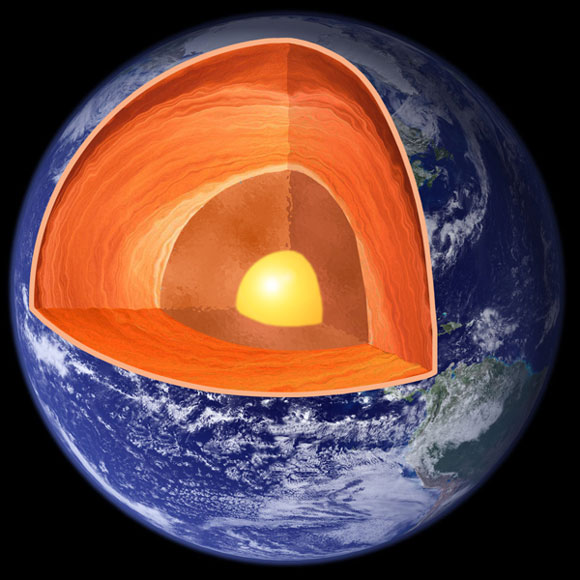
We not know a lot about the interior of our planet, but we can make some good guesses. Our planet comprises metal and rock, mostly. The majority is solid, but there is a portion on the inside that is a liquid. This liquid is molten rock near the center.
The rock layer closest to us at the surface is called the crust. Crust comprises basalt rocks and covers over half of the Earth’s surface. A majority of this is under the oceans and is very hard for anyone to study in those areas.
The layer beneath the crust is called the mantle. It is much thicker than the crust and is denser as well. It is mostly solid but does contain pockets that are molten.
Finally, we have the core at the center of the planet. It is even more dense and hot there. It is mostly solid and is the size of smaller planets. The core is made up of metals and dense rock.
Since the Earth is divided into sections, most think the core was entirely molten. If it was molten, this would allow the heavier elements to sink toward the center core.
Magnetic Field
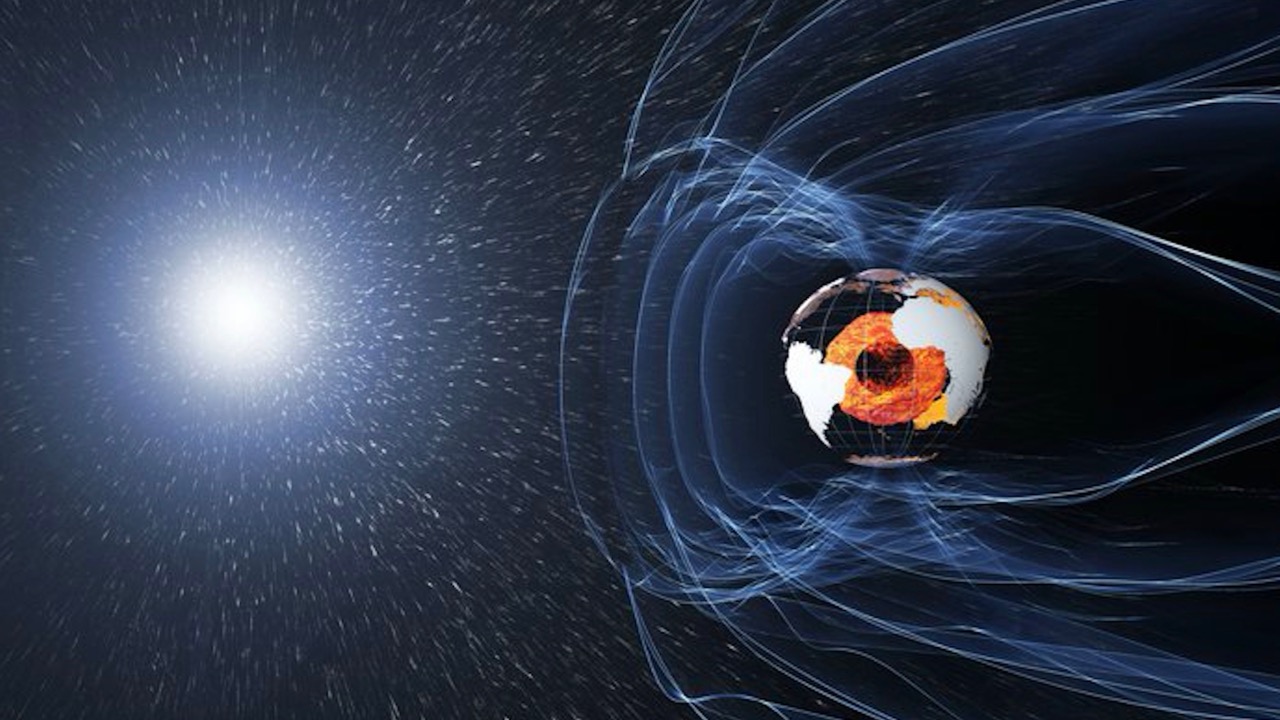
Our planet has a decently strong magnetic field. It affects a lot throughout the interior. Just like in stars, it formed the magnetic field from hot and dense metal moving in the center. Our magnetic field extends away from the Earth’s surface into space. It traps a lot of dangerous radiation there that would otherwise hit the surface.
The region where the magnetic field keeps out these particles is the magnetosphere. It protects us and is vital to our survival on Earth. These dangerous particles usually come from the Sun with the solar wind.
The Crust
There is a lot going on in our crust. Volcanic eruptions created a lot. Erosion by wind and water constantly reforms it. The Earth is the most geologically active planet that we know of. The crust is made of basalt, with the remaining portion being granite.
Tectonics
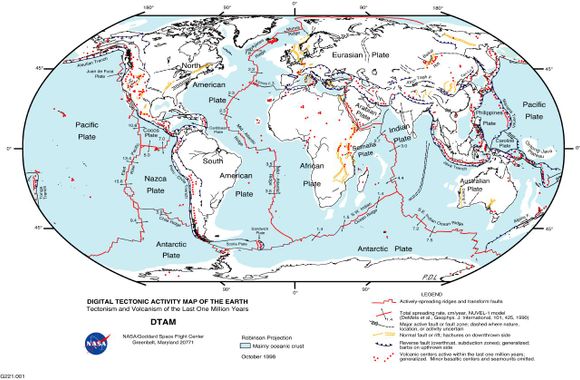
Plate tectonics describe the movement of rock in the mantle. These large sections of rock creep along. They have been doing so since the formation of this planet. This movement forms mountains and other large planetary features.
While plate tectonics is often the domain of Geology, it plays a role in Astronomy as well. This is because formation of other planets in the Solar System and beyond must go through many of these same processes. By learning about our own planet, we can surmise details about other planetary spheres.
Tectonics cool the planet. If there is any purpose to it, then it is this. Heat originates around the core and must go somewhere. The shifting of mantle sections brings this heat to the surface.
We divided the crust up into several plates. These plates are below the oceans and landmasses on the surface. They all fit together, but are constantly moving. In fact, the continental structure of our planet is continually evolving. Some plates are moving away from the ones closest to them, while other plates are moving toward their respective partner plates.
The plates move through the convection system. Convection is the transfer of heat which causes cooler material to sink and warmer material to rise.
When the plates run into each other, mountains form and other large changes occur. We can describe these interactions of plates in a couple ways. They are rifts and rises.
A rift is where plates are getting farther apart and causing continents to move away from each other. A rise is the opposite effect. This is where plates are getting closer and their respective continents are being pushed together.
Earth’s Atmosphere
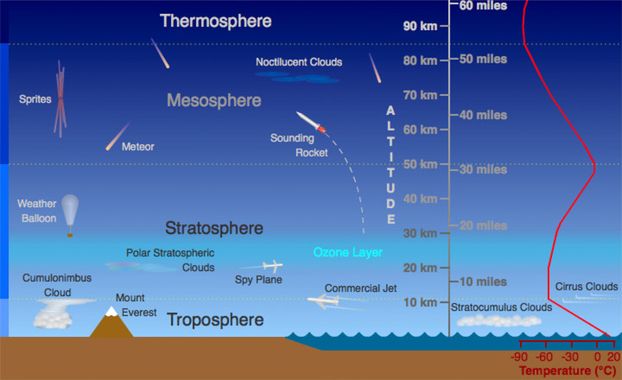
Most of our atmosphere, by mass, is concentrated near the surface. We live at the bottom of the atmosphere. The troposphere is here and is another example of convection. Warm air rises and while cooler air is forced downwards.
In the troposphere, the warmest air is near the bottom, while the coolest air is at the top. Above the troposphere is the stratosphere, which is freezing and moisture free.
At the edge of the stratosphere layer is the famous ozone layer. This is another form of oxygen and it has a different chemical formula. Since it is denser oxygen, it is very effective at stopping radiation from outer space, harming us here on Earth.
The atmosphere consists mostly of nitrogen and oxygen. There are a few other trace amounts of gases. These gases form a fine balance for our living conditions. If there were less or more of them, life would not be possible in the way we know it currently.
We do not know how our atmosphere originally formed. There are guesses involving impacts from outer space, volcanic activity, and formation along with the surface. There is evidence of them all, so deciding on one is not feasible right now. So, most think it is a combination of these events.
Earth’s Weather
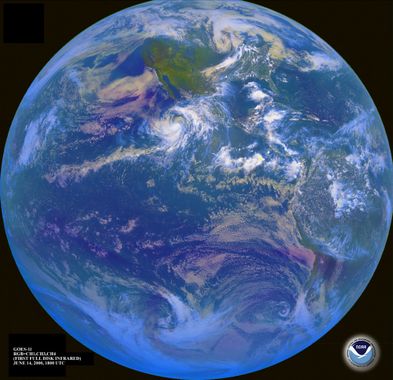
Every celestial object with an atmosphere has weather. Weather is the circulation of our atmosphere and its effects on the surface. The Sun plays a significant role in our weather patterns. Its radiation heats the surface, which gives the atmosphere energy.
Rotation of the Earth plays a role as well. As our planet spins, different areas get direct sunlight. This will create weather patterns unique to those particular areas. Weather has the same effects year after year in regions. This gives rise to a climate that does not change much when looked at for long periods of time.
Climates change, though. Change often takes thousands of years for permanent effects to take place. However, change has happened continually on Earth for its multi billion year history.
Therefore, we should not be surprised that climates change and different regions shift its weather patterns. For example, oceans became deserts and vice versa. This has happened many times in our history and will happen many times more.
Life On Earth
Since the Earth is the only place we have identified life, scientists have been trying to figure out why this is. Life has been here since our planet’s very beginning stages. We do not know how long life has been here, but it’s estimated to be around 4 billion years.
Why did life form here but in no other place in our Solar System? There is not an answer for that yet. Many planets have similar formations. We can assume close to the same conditions in countless other planets in other Solar Systems too.
Our atmosphere and surface were much different 3-4 billion years ago. There was very little to no oxygen early in our history. Despite this, life has consistently grown and and become more sophisticated.
Why Is The Sky Blue
The sky is blue because of the scattering throughout our atmosphere. Specifically, light is scattered through air and dust molecules. Scattering is where radiation is absorbed and redirected. When radiation is redirected, blue light is scattered easier.
Blue light is scattered easier because its wavelength is on the smaller side. Since it is smaller, it gets distributed through the air more. This makes our sky blue.
This effect is also why the Sun appears yellow or orange, depending on time of day. In the early morning or late evening the Sun will appear orange. This is because radiation of the Sun has a lot more atmosphere to travel through to reach our eyes than midday.
Since there is more atmosphere to travel through, the blue wavelengths are almost totally gone or scattered through the atmosphere by the time that radiation reaches our eyes. Being gone, all that is left are the other wavelengths. This makes the Sun appear orange to us.
Conclusion
So, why does the Earth support life? The Earth supports life because it has the perfect balance of processes that I have been talking about. These include interior processes and magnetic fields that power the atmosphere and protect the Earth from dangerous radiation.
There are also tectonics that continually renew the planet’s crust despite the horrible impacts from early in our planet’s history. Of course, we have our atmosphere that gives us the oxygen to breathe, that we could certainly not do without.
All these processes give us life. This life has been here and constantly struggling for billions of years. Despite life being almost wiped out many times, it has come back strongly every time.
Why is our planet the only one to be going through this? We certainly do not know yet. We may find life elsewhere one day, but then again, we may not. It is certainly a great mystery. Perhaps other planets have had life in their past but it’s gone now.
If that is the case, planets could all have a rise and fall of life in their histories. This may mean we are the current life supporting planet. Who knows? Hopefully, we will find clues one day.
Thanks For Reading
Thank you for reading this, I really appreciate it.
If you would like to join my newsletter, you can do so here:
If you need a suggestion on what to read next, then try these Astronomy articles:
Introduction To The Solar System
Orbital Motion In The Solar System